Treatment Record Summary â User Guide - National Cancer ...
Treatment Record Summary â User Guide - National Cancer ...
Treatment Record Summary â User Guide - National Cancer ...
- No tags were found...
Create successful ePaper yourself
Turn your PDF publications into a flip-book with our unique Google optimized e-Paper software.
<strong>Summary</strong> of evaluation findingsThe TS has been positively received in both primary and secondary care. 80% ofGPs found the summary useful or very useful and on the content made constructivesuggestions for improvement. Over 50% felt it would make a difference to the waythey manage patients and 90% wanted its use to continue. The majority of hospitalclinicians recognised the value of summarising what could be months of treatmentand holistic care into a concise summary. Some voiced concerns about thecomplexity of content and length of time it took to complete whilst others found it hadlittle impact on time once they became familiar with it... One clinician felt that ‘it madeus document and communicate better’ another thought it to be ‘excellent’. .Presentation StyleThere are three presentation styles you may wish to consider, the standardform/template, a letter that follows the template or an electronic solution.Most test sites used the template and boxes in the format provided; others convertedto a letter template to improve ease of use by secretarial staff. Two sites createdelectronic versions using an access database with a series of drop down menus toaid the speed of completion. One site transmitted the TS electronically to the GP,others printed and posted. One consultant completed the TS in place of the clinicletter and provided a copy for the patient to take with them when leaving the clinic.Recommended PracticeThe following standards support the ongoing use of the TSThe TS should be completed promptly and sent to both parties within 6 weeks ofthe end of initial treatment for cancer.The completed TS should be sent to both the patient (having agreed to be copiedinto all correspondence) and the GP within 2 weeks of the appointment at the endof treatmentEffort should be made to complete all sections. Where patients do not wish todiscuss or know the prognosis or treatment intent a separate letter to the GP maybe indicatedTS updates should be generated at key points e.g. following recurrence, furthertreatment or a transition to end of life careThe TS should not replace detailed care plan based on an assessment of needMembers of the MDT involved in the patients care should contribute to thecompletion of the TSGPs should ensure the patient is entered onto appropriate monitoring and reviewsurveillance systems if required.NCSI <strong>Treatment</strong> <strong>Summary</strong> user guide V 3 Dec 2011
Revised <strong>Treatment</strong> <strong>Summary</strong> templatesThe TS has been amended since testing to remove less useful informationAppendix 1 provides the revised TS template with updated GP READ codes.Appendix 2 provides a user guide with rational for data inclusion and anindication of the essential and desirable fields required should local re-design ofthe form be preferred.Appendix 3 provides an example template with prompt notesAppendix 4 provides the same information in a letter templateHints and Tips for implementation:The following hints and tips have been provided by the NHS Improvement test sites:Engage administrative staff early in change process and encourage them tosuggest the best way to implement locallyKeep primary leads informed of planned changes to documentation and bereceptive to further changes they may suggest.Avoid handwriting the TS - type up where possibleProvide a laminated prompt list in clinic for clinicians to use as they dictateTo encourage uptake, encourage testing for say 5 patients and then reviewcontent and process. Ensure review occursIf redesigning template beware of removing fields as they may be useful to othersCreate template letter with headings to enable easier typingUse the TS in place of a clinic letter one clinic occasion and reference completionof the TS in the clinic notes and place copy in the case notesEnsure that the medical records department are aware of the additional proformaand aware of the appropriate place in the notes for filing (this will avoid thembeing removed from the patient’s records inappropriately).Colour code the form/letter to denote sections for doctor and CNS to completeCNS in one Trust completes as much as possible prior to the appointment withthe remaining sections completed by the doctorAttach the template prompt list to the front of case notes prior to the patient beingseen in clinicPre-fill the boxes where possible such as for common signs and symptoms ofrecurrence, treatment toxicitiesFor complex tumour group consider separate list of signs and symptoms, what todo and key contacts if help required (examples available on request to NHSImprovement Survivorship Team)If template set up as electronic database add common signs symptoms andmedications as drop down menusNCSI <strong>Treatment</strong> <strong>Summary</strong> user guide V 3 Dec 2011
Share testing and experience with other colleagues to encourage wider testingand spread of the use of the TS.Provide GP READ codes attached to each letter or issue separatelyFeedbackTo provide further feedback and comment please contact:Dr Rosie Loftus – GP Macmillan Lead rloftus@macmillan.org.uk or Noeline Youngnyoung@macmillan.nhs.ukNCSI <strong>Treatment</strong> <strong>Summary</strong> user guide V 3 Dec 2011
Appendix 1<strong>Treatment</strong> <strong>Summary</strong>Insert GP Contact DetailsInsert Trust Logo and AddressDear Dr XRe: Add in patient name, address, date of birth and record numberYour patient has now completed their initial treatment for cancer and a summary of theirdiagnosis, treatment and ongoing management plan are outlined below. The patient has acopy of this summary.Diagnosis: Date of Diagnosis: Organ/StagingLocal/Distant<strong>Summary</strong> of <strong>Treatment</strong> and relevant dates:<strong>Treatment</strong> Aim:Possible treatment toxicities and / or late effects:.Advise entry onto primary care palliative orsupportive care registerYes / NoDS1500 application completedPrescription exemption arrangedYes/NoYes/NoAlert Symptoms that require referral back to specialist team:Contacts for re referrals or queries:Secondary Care Ongoing Management Plan: (tests, appointmentsetc)In Hours:Required GP actions e.g. ongoing medication, osteoporosis and cardiac screeningOut of hours:Referrals made to other services: (delete)District NurseAHPSocial WorkerDieticianClinical Nurse SpecialistPsychologistBenefits/Advice ServiceOtherA <strong>Cancer</strong> Care Review is also required<strong>Summary</strong> of information to the patient and/or their carer:Additional information relating to lifestyle and support needsCompleting Doctor:Signature:Date:NCSI <strong>Treatment</strong> <strong>Summary</strong> user guide V 3 Dec 2011
GP READ CODES – CANCER (For GP Use only)System 1 5 digit codes All other systems 4 digit codesDiagnosis:DiagnosisLung Malignant Tumour XaOKG Lung <strong>Cancer</strong> .B222Carcinoma of Prostate X78Y6 Prostate <strong>Cancer</strong> .B46Bowel Intestine X78gK Malignant neoplasm of Rectum .B14Large Bowel X78gN Malignant neoplasm of Colon .B13Female Malignant Neoplasia B34 <strong>Cancer</strong> female breast .B34Male Malignant NeoplasiaB35Histology/Staging/Grade:Histology Abnormal4K14Tumour grade X7A6m Tumour staging .4MDukes/Gleason tumour stage XaOLF Gleason .4MORecurrent tumour XaOR3 Recurrence of tumour .4M6Local Tumour SpreadX7818Mets from 1° XaFr Carcinoma metastases .BB13<strong>Treatment</strong>Palliative Radiotherapy 5149 Tumour palliation .5149Curative Radiotherapy XalpH Radiotherapy .7M371Chemotherapy x71bL Chemotherapy .8BADRadiotherapyXa851<strong>Treatment</strong> Aim:Curative procedure Xallm Curative procedure .8BJOPalliative procedure XaiL3 Palliative procedure .8BJ1<strong>Treatment</strong> toxicities/late effects:Osteoporotic #Xa1TOOsteoporosis XaELC Osteoporosis .1409InfectionXa9uaOngoing Management PlanFollow up arranged (1yr)XaL.No FU 8HA1 No follow up arranged .8HAReferral PRN8HAZReferrals made to other services:District NurseXaBsnSocial WorkerXaBsrNurse SpecialistXaAgqSALTXaBT6Actions required by the GPTumour marker monitoringXalqgPSAXalqhOsteoporosis monitoring XalSd Osteoporosis monitoring .66AReferral for specialist opinionXalstAdvised to apply for free prescriptions 9D05 Entitled to free prescriptions .6616rMedication:New medication started by specialist XEOhn Medication given .8BC2Medication changed by specialist 8B316Advice to GP to start medication XaKbFAdvice to GP to stop medication XaJC2Information to patient:DS1500 form claim XaCDx DS1500 .9eb5Benefits counselling 6743<strong>Cancer</strong> information offeredXalmLNCSI <strong>Treatment</strong> <strong>Summary</strong> user guide V 3 Dec 2011
<strong>Treatment</strong> <strong>Summary</strong> <strong>User</strong> <strong>Guide</strong> Appendix 2Field Rationale for inclusion EssentialorDesirableDiagnosisImportant for the GP and patient to know type of cancer and location of Ecancer and the likely source of secondary recurrence.Organ Staging/local or distant spread Information about staging and spread provides insight into prognosis and D(Grade)Date of Diagnosis<strong>Summary</strong> of <strong>Treatment</strong> and relevantdates<strong>Treatment</strong> AimPossible treatment toxicities and or lateeffects of treatmentrisk of recurrenceTo understand length of time patient has known diagnosis and time periodbetween referral from primary care and diagnosis to learn where delayscan be minimised in future. Important data to monitor treatment outcomesin relation to survivorship. Helps plan date of GP <strong>Cancer</strong> Care Review.To understand the range and order of modality treatment, understand thelikely sequence of treatment effects. Essential to inform future treatmentchoice if further disease occurs. Important information for patients wishingto take out insurance or a mortgage.To understand whether treatment intended is curative, palliative or forsymptom relief as this will help GPs to understand aims of treatment referback to secondary care or other services appropriately. Also help GPs toanticipate future care needs.Patients undergoing cancer treatments may be more prone to toxicity andlate effects of treatment such as osteoporosis or heart disease. Inclusionof risks in this summary triggers the entering of the patient onto routine GPsurveillance (QOF related). Signs and symptoms addressed earlier mayimprove quality of life and treatment outcomes from side effects or lateconsequences of treatment.Inclusion of suggested or preferred treatment associated with toxicities andlate effects can be initiated without referral back to the specialist.Raises awareness of common late effects and reduces delays to furtherinvestigation and treatment. This may also impact on survival rates assymptoms are picked up soonerDEEENCSI <strong>Treatment</strong> <strong>Summary</strong> user guide V 3 Dec 2011
Advise entry onto palliative or supportivecare registerKey contact in hours for advice and reaccessDS 1500 status and prescriptionexemptionAlert symptoms that require referral backto specialist teamContact for re referrals or queries in andout of hoursSecondary Care On-going ManagementplanReferrals to other servicesInclusion of the patient on the palliative care register ensures that the outof hours(OOH) teams are made aware that a patient is nearing end of lifeand that increased input maybe required to support patient and carers.Register is shared with all relevant OOH doctors, ambulance service,community district nursing teams, Macmillan support team, social care,hospice as appropriate. Patients can then receive the appropriate support,information and benefits.To ensure the patient, GPs and primary care team know who and when tocontact should they have queries or concerns. The contact should be ableto triage enquiries and initiate actionIf no DS 1500 completed the GP will be prompted to arrange. Also ensuresthat exemption charges are waived for any cancer treatment - anentitlement for all patients with a diagnosis of cancerThis should include only those symptoms where immediate re-referral tosecondary care specialist is required e.g. acute breathlessness requiring apleural tap, as opposed to the expected side effects of treatment that canbe managed by the GP or community team. Improved information to thepatient will also enable better patient choice especially related to End ofLife Care.Confirms contact details for the patient or GP for advice on care ortreatment or to arrange urgent review. The out of hours contact could be award, the acute oncology team or relevant on call teamInclude any planned outpatient reviews and surveillance tests dates (orapproximated timescales). This provides a framework for GPs. If indicated,further tests can be scheduled prior to the further outpatient visits. Patientswill be better informed about follow up plans and what to expect. It isreassuring to patients and carers to see the planned care, surveillance andsupport, they then know what to expect and when.Helps avoid duplication of referral if the patient visits the GP betweenappointments and is unsure of who is involved in their care. Particularlyuseful in respect social care referrals and whether the patient is known toother agencies. Can help to reinforce the importance of attendingDEDEEEDNCSI <strong>Treatment</strong> <strong>Summary</strong> user guide V 3 Dec 2011
<strong>Treatment</strong> <strong>Summary</strong> Example Appendix 3Dear Dr JonesRe: John Smith, 3 Park Road, Doncaster DN4 DEF DoB: 10.10.10 NHS No: 123456Your patient has now completed their initial treatment for cancer and a summary of theirdiagnosis; treatment and ongoing management plan are outlined below. The patient has a copyof this summary.Diagnosis:Colorectal <strong>Cancer</strong>Date of Diagnosis:10.02.10Organ/Staging – Dukes T2Local/Distant – N0<strong>Summary</strong> of <strong>Treatment</strong> and relevant dates:Surgery – Resection (March 10) and reversal of stoma (Sept 10)Radiotherapy - May – June 2010Possible treatment toxicities and / or late effects:Diarrhoea following pelvic radiotherapy.<strong>Treatment</strong> Aim:CurativeAdvise entry onto primary carepalliative or supportive care registerNoDS1500 application completed- NoPrescription Charge exemptionarranged- YesAlert Symptoms that require referral back to specialist team:Diarrhoea for more than 2 weeks not relieved by loperamide/codeineBlood or mucus per rectumFurther change in bowel functionAbdominal pain that persists for longer than 4 weeks and does notrespond to simple analgesiaContacts for re referrals or queries:In Hours: 01234 567890 (CNS team)Out of hours: 01234 987654 (oncologyward)Referrals made to other services:Secondary Care Ongoing Management Plan: (tests, appointments etc)Next OP Review - Jan 2011CEA next due in Jan 2011 then annually until 2015CT scan (abdo and chest) next due Sept 2011Colonoscopy repeat next due Sept 2015Required GP actions e.g. ongoing medication, osteoporosis and cardiac screeningCommunity DieticianBenefits/Advice ServicePlease review dose of XXXXX in two months if symptoms of XXXX resolved reduce to 4mg daily<strong>Cancer</strong> Care Review within 3 months<strong>Summary</strong> of information to the patient and/or their carer:Patient and wife informed that the cancer in his colon was non invasive and that he has received surgery and radiotherapywith curative intent. He is aware however that it may recur in the future and we have briefly discussed the further treatmentavailable should this be required. He is fully aware of the symptoms of recurrence and what to do should any occur.Additional information relating to lifestyle and support needsPatient advised to quit smoking and referred to smoking cessation clinicPatient keen to join local colorectal support group and plans to attend next session in NovemberCompleting Doctor: Charles Goodenough Signature:Date: 30.10.10NCSI <strong>Treatment</strong> <strong>Summary</strong> user guide V 3 Dec 2011
Template in letter formatAppendix 4Date: XXXXXXXXDear Dr Enter GP name XXXXRe:Your patient has now completed their initial treatment for cancer and a summary of theirdiagnosis; treatment and ongoing management plan are outlined below. The patient has a copyof this summary.Diagnosis:Date of diagnosis:Staging:<strong>Summary</strong> of treatment and relevant dates:<strong>Treatment</strong> Aim:Possible treatment toxicities and / or late effects:Alert symptoms that require referral back to specialist team:Secondary Care Ongoing Management Plan: (tests, appointments)Required GP actions: (e.g. Medication, osteoporosis/cardiac screening)<strong>Summary</strong> of information given to the patient and/or their carer:Additional information including issues related to lifestyle and support needs:Advise entry onto primary care palliative or supportive care register: (Yes/No)DS1500 application completed: (Yes/No/N/A)Prescription charge exemption arranged: (yes or No)Contact for re-referral or any queries;In hoursOut of hours:Yours sincerelyConsultant xxxxxxxxCC: Insert patient nameNCSI <strong>Treatment</strong> <strong>Summary</strong> user guide V 3 Dec 2011


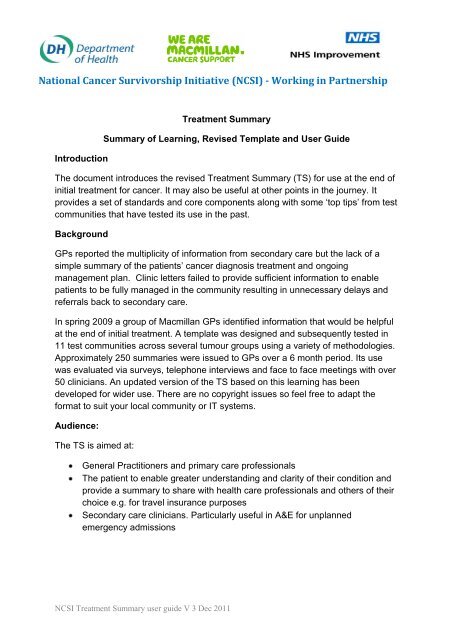
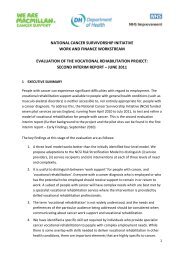
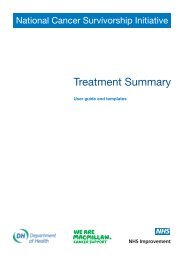

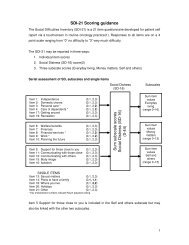

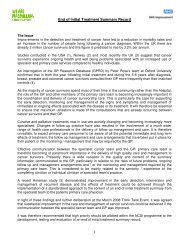
![Download the how to guide [PDF] - Macmillan Cancer Support](https://img.yumpu.com/47067428/1/184x260/download-the-how-to-guide-pdf-macmillan-cancer-support.jpg?quality=85)
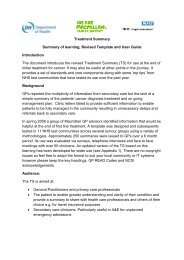
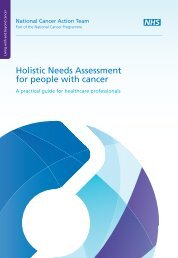
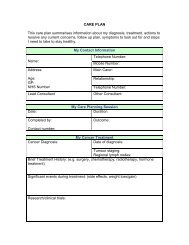

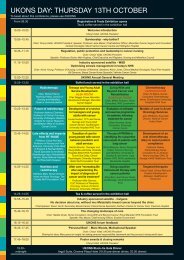
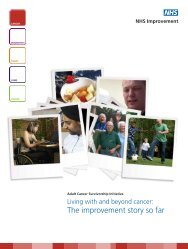
![HOPE Protocol [PDF, 420KB] - National Cancer Survivorship Initiative](https://img.yumpu.com/32566432/1/184x260/hope-protocol-pdf-420kb-national-cancer-survivorship-initiative.jpg?quality=85)